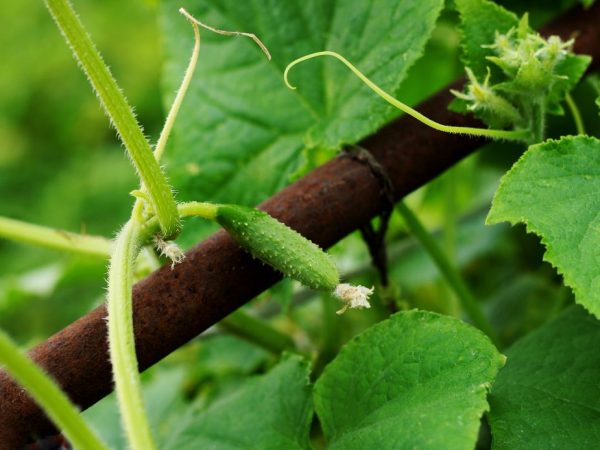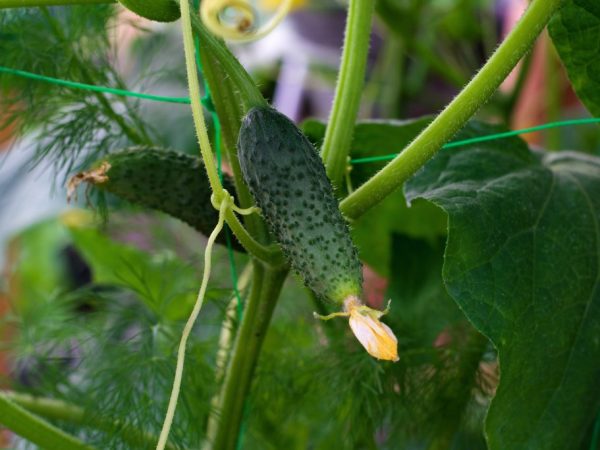What microelements are missing in cucumbers
Cucumbers are a rather whimsical vegetable crop, but if you organize the cultivation process correctly, you can harvest a good harvest even in lean years. The main attention should be paid to the nutrition of the cucumbers. Consider what trace elements this vegetable needs and how the lack of one or another nutrient affects it. Let's pay attention to the question of what trace elements are lacking in cucumbers, if they turn yellow or grow slowly.

Implications of micronutrient deficiencies for cucumbers
Microelements necessary for cucumbers
This vegetable crop most of all needs 3 microelements:
- Nitrogen. Stimulates the formation of green mass. Accordingly, it is advisable to apply nitrogen-containing fertilizers at the beginning of crop growth.
- Phosphorus. Stimulates the development of the root system. Phosphorus deficiency leads to the fact that cucumbers do not absorb the necessary trace elements from the soil, so the need for phosphorus at all stages of cultivation is great.
- Potassium. Stimulates the ripening of fruits, therefore potash fertilizers should be added during the fruiting period of the vegetable crop. Lack of potassium negatively affects the palatability of the fruit.
In addition to these trace elements for normal development, the plant needs magnesium, calcium, copper, boron, sulfur, manganese, iron, zinc.
Lack of each of the above trace elements negatively affects the health and growth of cucumbers. This, in turn, will lead to crop loss. The plant needs different micronutrients at each stage of development.
Let's consider how to determine the deficiency of each microelement important for cucumbers by the appearance of the plant.
Nitrogen deficiency
The fact that cucumbers lack nitrogen can be judged by several signs. First of all, take a closer look at the formation of shoots. Since the plant does not have the strength to form green mass, the shoots are poorly formed. Even the appearing processes develop very slowly.
Small leaves also speak about the lack of nitrogen. Their size does not correspond to the standards of the variety, moreover, they acquire a light green color. With a serious lack of this trace element, the leaf plates turn yellow. If no action is taken, the leaves will eventually fall off the weak vines.
Another indication of a nitrogen deficiency is the weak formation of the ovary. During the fruiting period, the lack of nitrogen negatively affects the size of the fruit.
Phosphorus deficiency
The lack of phosphorus can be judged by the color of the leaf plates. A slightly bluish tint appears at first. With a significant lack of phosphorus, the leaf plates turn reddish. But the color change only occurs on older leaves. Young leaf plates, which are small in size, also indicate the lack of a trace element.
If we are talking about a period of active growth of vegetable crops, then the lack of phosphorus also negatively affects the formation and growth of shoots. Much less ovary forms than it should.As for the fruiting period, with a phosphorus deficiency, cucumbers ripen very slowly.
Potassium deficiency

Potassium deficiency makes cucumbers bitter
Potassium deficiency can be determined by the excessive green color of the leaves. At the same time, along the edge of the plant there is a thin strip of yellow color. Over time, the edges of the leaves dry out. During the period of active growth, excessively long shoots are formed. Despite the active growth of shoots, there is practically no ovary on the vegetable crop.
As for the fruiting period, with a deficiency of potassium, cucumbers become excessively filled with water and become bitter. In addition, their shape changes slightly. At the base, the fruits lengthen. With an excessive lack of potassium, the plant begins to wilt. The first to wither are young shoots that have not had time to gain nutrients.
Deficiency of other elements
Let's consider how the lack of microelements, which are considered minor, affects the vegetable crop.
- Magnesium. The lack of magnesium in cucumbers manifests itself primarily on leaf plates, which in appearance seem to be burned. If you do not take any action, over time, spots appear on the leaves located in the lower part of the plant, painted first in a pale green, and then in yellow. With a strong lack of magnesium, only the veins of the leaf plates remain green, and the rest of them turn yellow.
- Copper. The lack of this element leads to the fact that the leaf plates become pale, and the shoots wither. With a significant copper deficiency, the ovary crumbles.
- Bor. This nutritional element is very important in the phase of active growth of the vine. With a shortage of boron, growth points die off. Accordingly, even shoots that look strong and healthy begin to wither. Even in the absence of the required amount of boron, the ovary crumbles.
- Calcium. The lack of this trace element can be judged by the whitish stripes that have appeared on the leaf plates. These stripes form along the veins and widen over time, leading to wilting and leaf fall. Even with a calcium deficiency, the plant is affected by rot. It first appears on the ovary, then spreads to the stem and root. If there are already fruits on the liana, they also begin to rot.
- The first signs that a vegetable crop lacks phosphorus are dry spots that have appeared on the lower leaf plates. First, the growth of shoots stops, after the ovary falls off and the vine withers.
- Sulfur. With a lack of sulfur, much more veins appear on the leaf plates and their color changes slightly.
- Manganese. Manganese deficiency in cucumbers is accompanied by the appearance of small whitish specks on the leaf plates located in the upper part of the vine.
- Iron. Signs of iron deficiency are the appearance of whitish streaks along the leaf veins and a slowdown in shoot growth. If there are already fruits on the liana, their tops become whitish.
- Zinc. With a lack of zinc, the leaves begin to turn yellow. Young leaf plates have an asymmetrical shape.
We will not consider what can be done with a shortage of each specific micronutrient. The solution to the problem is the same in all cases: the appropriate fertilizer is applied to the soil.
It is important not to overdo it when fertilizing. An excess of trace elements affects the vegetable crop in the same way as their lack.


